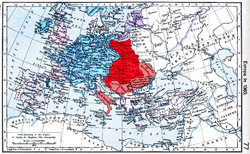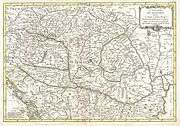Lands of the Hungarian Crown
The Lands of the Hungarian Crown[1][2][3] were a group or territories ruled nominally or absolutely by the Hungarian king.

In 1102 Kingdom of Croatia entered a dynastic union with Hungary under the reign of King Coloman and Croatia became an autonomous kingdom within the Hungarian Crown. The succeeding Hungarian kings bore the title "King of Croatia and Dalmatia".
The medieval Kingdom of Bosnia was also a long time part of the Hungarian Crown.[4] The Hungarian rulers used the title "King of Rama" for their Bosnian lands.
Emeric of Hungary began to use the title "King of Serbia" for his Serbian suzerainty.
Principality of Halych was attached to the Lands of the Hungarian Crown during the rule of Andrew II of Hungary and the king adopted the title "King of Galicia".[5] The subsequent kings usually used the title "King of Lodomeria and Galicia".[5] The word "Lodomeria" referred to Volhynia.
Béla IV of Hungary extended his rule over Cuman inhabited territories (the latter Wallachia and Moldavia) and used the title "King of Cumania".
During his reign, Stephen V of Hungary managed to seize areas in Bulgaria and local nobles accepted his vassalage. He used the title "King of Bulgaria".
The three regna

Between 1526 and 1541 Hungary disintegrated into three parts. From the 16th century, Hungary proper, Croatia and Transylvania were the three regna of the Crown.[1] These lands had some links with each other but became more and more autonomous during the centuries.[1]
In the 18th century, the Lands of the Hungarian Crown consisted of the Kingdoms of Hungary, Croatia and Slavonia with the city of Fiume, the Grand Principality of Transylvania, the Croatian-Slavonian, and the Serbian-Hungarian military frontiers.
Galicia was acquired by the Habsburgs in the name of the Hungarian Crown, however it wasn't attached to Hungary.[1]
During the Hungarian Revolution of 1848 the Hungarian government proclaimed in the April Laws of 1848 that Transylvania became fully integrated into Hungary, however, after the fall of the revolution, the March Constitution of Austria defined that the Principality of Transylvania as being a separate crown land that is entirely independent of Hungary.[6]
In 1867, the Crown's two regna Transylvania and Hungary were reunited in the process of the creation of Austria-Hungary, however Croatia kept and improved its position as an autonomous realm within the Lands of the Crown of Saint Stephen.
After World War One, Transylvania was ceded to Romania and Croatia merged into the Kingdom of Serbs, Croats and Slovenes.
References
- 1 2 3 4 Laszlo Péter, Hungary's Long Nineteenth Century: Constitutional and Democratic Traditions in a European Perspective, BRILL, 2012, pp. 51-56
- ↑ David F. Good, The Economic Rise of the Habsburg Empire, 1750-1914, University of California Press, 1984, p. 3
- ↑ Alan Sked, Radetzky: Imperial Victor and Military Genius, I.B.Tauris, 2011, p. 3
- ↑ Marko Attila Hoare, The History of Bosnia: From the Middle Ages to the Present Day, Saqi, 2007, p. 35, ISBN 9780863569531
- 1 2 Vasylʹ Mudryĭ, Lviv: A Symposium on Its 700th Anniversary, 1962, p. 62
- ↑ Austrian Constitution of 4 March 1849. (Section I, Art. I and Section IX., Art. LXXIV)
